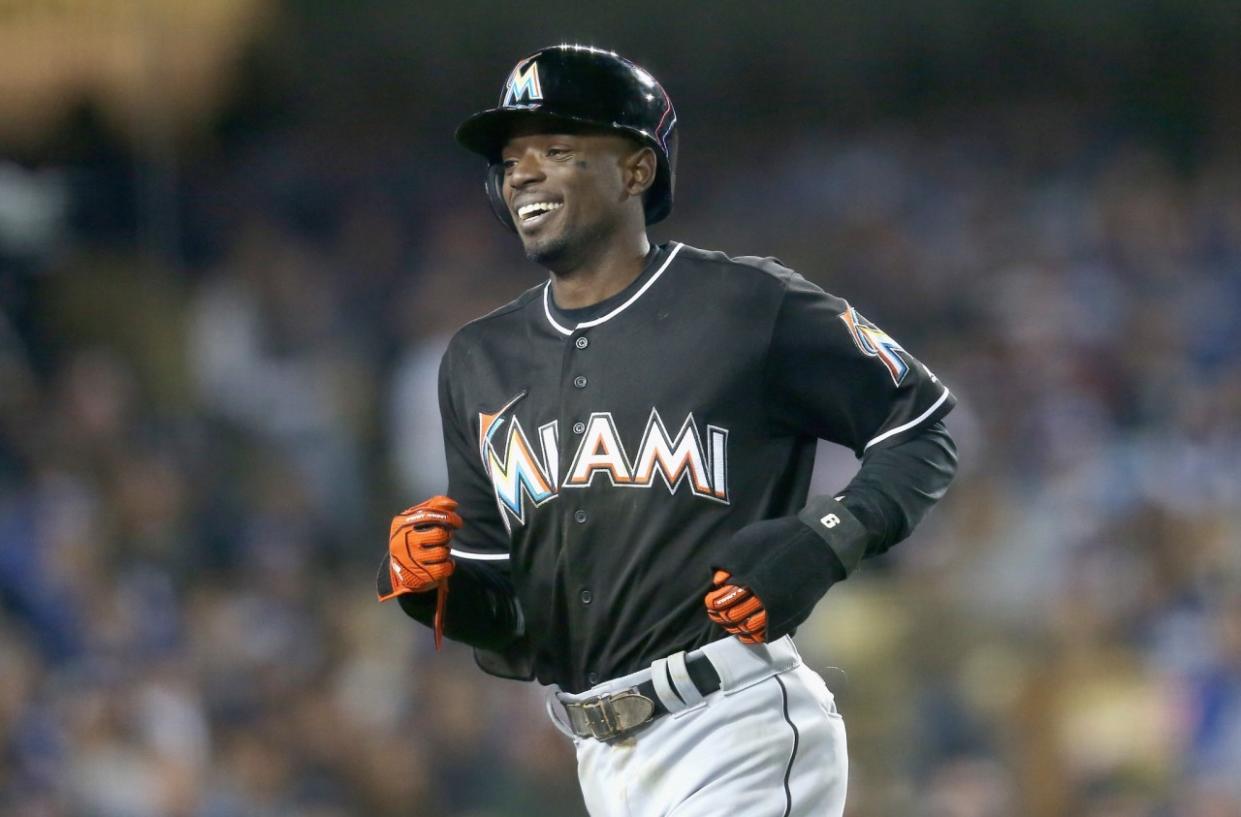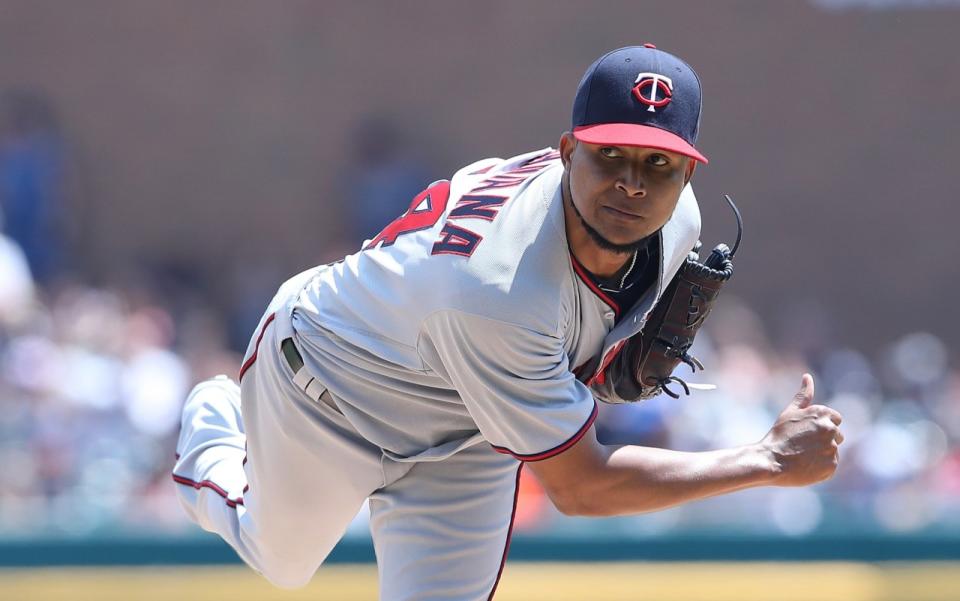Marlins hoping Dee Gordon of old returns following PED suspension

Along comes Dee Gordon, spirited in journey, ruthless in ambition, shamed in reputation, the prodigal second baseman.
Along comes Dee, 80 games late by his own hand, into a baseball season that went on without him, that, should the Miami Marlins continue on this road, will end without him too.

The game has become familiar with the goings and comings of the men who dabble in strip-mall science, so Dee will return to his clubhouse as a good friend and teammate, as a brother in a family that prioritizes batting titles and Gold Gloves over most everything else. That’s the business. That’s the game. Fact is, nobody doesn’t like Dee Gordon, the wispy kid who could run a little that turned himself into a legit big-leaguer, and even if they were mad on the night of April 28 — and they probably weren’t — it would be impossible to stay mad at Dee Gordon for three months.
Eligible to return from his PED-related suspension Thursday night in Miami against the St. Louis Cardinals, Gordon was seven for 27 in seven rehab games for the New Orleans Zephyrs. He looked like the same old Dee, uniform pants puckered at the waist beneath a belt cinched too tight, jersey fluttering beneath his narrow shoulders. His game plays exactly as you’d suspect, given he is lean as a guitar neck and quicker than a riff.
What happens now would be a guess. Who Gordon is today, three months later, would be a guess. Who he’ll be for the remainder of a contract to which the Marlins signed him in January — $50 million over five years — would be a guess. The game has become familiar with guessing.
The results of a spring training drug test say Gordon’s sample contained exogenous testosterone and Clostebol. That’s testosterone that wasn’t made by his own body coupled with what is known to be a mild anabolic steroid. Gordon said that if he put those chemicals in his body, “I did not do so knowingly.”
So there we are. Again. Believe the system or believe the man, or believe both. Believe it was just bad luck. It’s all as wispy as Dee himself. What remain are the Marlins and the next two months, an NL East race to be decided, a wild-card race to be run, and for a franchise that hasn’t sniffed the good side of October in 13 years.
According to those organizational folks who make these decisions, Gordon returns as the everyday second baseman. Derek Dietrich, who played second base on April 29 in Milwaukee and nearly every day since, returns to his utility role.
“Dee,” said a team official, “will be worked into playing as much as he can early. Derek makes us better when we can use him all over.”
Gordon, when he plays, which presumably will be often, is the leadoff hitter. In his absence, the Marlins hit Ichiro, J.T. Realmuto, Adeiny Hechavarria and Dietrich first, and Marlins leadoff hitters are second in the league in on-base percentage. Only the St. Louis Cardinals (and Matt Carpenter) are better.
So, four days from a trade deadline in which the Marlins seek at least one starting pitcher, over a month in which they’ve already acquired Fernando Rodney for the eighth inning, and in a season in which there’s no reason for them to get squeamish, they bring back their batting champion, their stolen base champion, their leadoff hitter, their All-Star.
Along comes the hope they recognize him.
A WEEK BEHIND:
As he organizes himself for the process of replacing Terry Ryan, Minnesota Twins owner Jim Pohlad has granted interim general manager Rob Antony autonomy over baseball decisions before and after the trade deadline, which means Antony is not under orders to clear salary — Ervin Santana’s, for one — in the coming days. The Twins are getting some play on Santana, owed about $46 million through 2019, along with shortstop/third baseman Eduardo Nunez and relievers Brandon Kintzler and Fernando Abad.

While the industry was, let’s say, charmed that Pohlad would seek a “loveable” GM, there remains a curiosity over what other attributes Pohlad will emphasize. You know, assuming that’s not the whole list. Twins insiders expect Pohlad to enlist the help of a search firm, and they believe he will prioritize a candidate steeped in statistical analysis. Under Ryan, the Twins’ analytics staff was four full-timers, which lies somewhere between light and very light, though certainly not non-existent, of which the Twins were accused. Ryan frequently asked his stats people to run the numbers on players and perceived trends, according to those in the room, though it is unclear how he weighed that information with more traditional factors.
Regardless, change is coming in Minnesota, and it’s expected to be big, and it could start this week, depending on how Antony perceives the market on the players who helped get them to this point.
A WEEK AHEAD:
It’s short-sighted to choose the direction of a franchise in four days, unless four days is all you have. The fence teams going into Monday’s deadline:
Royals: four games at Texas
Yankees: three at Tampa Bay
White Sox: one at Chicago Cubs, three at Minnesota
Rockies: four at New York Mets
SAW IT COMING:
Ichiro Suzuki will be the 30th player in major league history to reach 3,000 hits. Three thousand has been coming for more than 15 years, in a steady hail of line drives and clever opposite-field dunks and through-the-middle bounders and, yeah, 113 home runs, as a sleepy fastball or a sloppy curveball might just have stirred Ichiro to turn on one.

It remains remarkable that Ichiro is, at 43, not creeping up on but barreling toward 3,000, batting .337 with a .413 on-base percentage in a season that, pound-for-pound, could match some of the best of his career. His eighth-inning single Tuesday night brought him to 2,997 U.S. hits.
He debuted in the major leagues on April 2, 2001. Against the Oakland A’s at Safeco Field, he singled against reliever T.J. Mathews. That was one. On that day he was 27 years, 162 days old.
Of the 29 players who preceded Ichiro to 3,000, Wade Boggs debuted at the oldest age — 23 years, 299 days. Of the other 28, none was older than 22. So Ichiro gave them all a four-year start, at least. And while he will not catch Pete Rose or Ty Cobb or Hank Aaron or Stan Musial or most of the others, and while no one really counts the additional 1,278 hits accumulated in Japan, that Ichiro could start at 0 at 27 years, 161 days and stay long enough for 3,000 at any age is worthy of regard.
By the way, the youngest debut was Al Kaline, who played his first game at 18 years, 188 days and finished with 3,007 hits. Robin Yount debuted at 18 years, 201 days and finished with 3,142. Pete Rose, who had 4,256 hits, debuted at 21 years, 359 days.
DIDN’T SEE IT COMING:
Bryce Harper batting averages:
.224 vs. LHP
.225 at home
.200 in May
.200 in July
.188 with two out, runners in scoring position

And yet, Bryce Harper on base percentages:
.385 overall
.376 at home
.500 with runners in scoring position
.441 with men on
He hasn’t hit like himself for two months. And still nobody’s really dumb enough to pitch to him.

 Yahoo Nachrichten
Yahoo Nachrichten 

